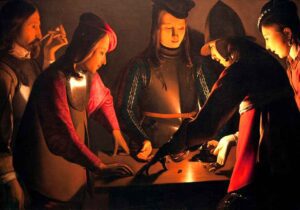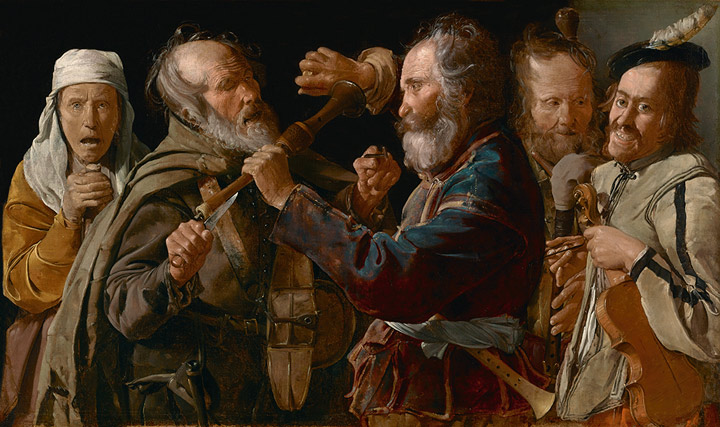Liviana Martin

The first exhibition in Italy dedicated to Georges de La Tour: 15 paintings out of 40 of certain attribution, compared with masters of his time, such as Gerrit van Honthorst, Paulus Bor, Trophime Bigot, Frans Hals
Let’s imagine that a dark room is illuminated by a dim candlelight and that from the dark one can decipher, little by little, the details of a face, a hand, an everyday object. Our vision focuses on what it can perceive, our mind perhaps pushes us to go further, beyond the visible, into the heart of darkness. This is what we are invited to do by the 17th-century French artist Georges de la Tour, renowned as a ‘painter of light’. He was rediscovered by critics after a long silence only in the early 1900s.
Many questions still surround his life and works. Born in Lorraine in 1593 to a humble family of bakers, he acquired the noble title thanks to his marriage to Diane Le Nerf, heir of a rich Lorraine family, who introduced him to the high society of the time. Increasingly esteemed for his paintings by contemporaries, in 1639 he became Painter to the King of France, Louis XIII.
We know about his character from judicial documents of the time: arrogant, violent, he tyrannized like a provincial lord with his pack of dogs. He lived in Luneville and, from what the chronicles tell us, the villagers couldn’t stand him: he was rich, owned lands and goods but, by ducal exemption, he didn’t pay taxes, and would clobber anyone who dared to touch what he owned.
If we were to rely on these biographical notes, we would expect violent, vital paintings; instead, and especially in the later ones, they reveal an extraordinary tenderness in portraying infants, children, mothers, saints in meditation, with an almost metaphysical manner that transfigures human beings in symbols. As André Malraux noted, La Tour is the painter of silence, of enchantment, of night that spreads out over the world; he interprets “the serene part of darkness”. He takes themes and characters from Caravaggio (the cheat, the fortune teller), but as if they were a distant echo, and the immobility of his works brings to mind Paolo Uccello or Giotto. His is a theater of statue-like characters, inserted in a flat, undefined space.
The first works, the result of youthful experimentation, are set in daylight. In the The Musicians’ Brawl the artist confronts us, using crude realism, with a violent altercation between musicians: while the two quarrellers fight, an old woman, with her silent scream, unloads all her unhappiness on us, forcing us to look at her.
It is a genre scene, widespread both in Italy (with Caravaggio) and in Flemish painting (Brueghel the Elder and Terbrugghen), but de La Tour interprets it in a particular way, showing detachment and a certain irony. Detachment, a subject that is also typical of French and Flemish art, is represented in the monumental Hurdy-gurdy Player with a Dog. Again the artist manifests his originality: the old man is painted full length, with a perspective from the bottom up. We do not feel particular involvement towards this elderly player who appears cold and unfriendly, while, perhaps, the only note of tenderness is given by the dog crouched at his feet, who looks at us with an imploring air. Note, in this as in other works, the hands of the characters: old and wrinkled, or youthful and almost crossed by the light, in any case they are hands that speak. It is no coincidence that the artist was the son and relative of bakers, who made a living with their hands.

In de La Tour’s later works his painting changes: the light becomes increasingly dim, the scenes, illuminated by a weak candle flame, become nocturnal. While illumination in Caravaggio’s paintings is given by a chink of light, a luminous passage that allows us to glimpse the characters, detaching them from the dark background, the light of the French artist places the protagonists of the work in a timeless atmosphere. “The flame of a candle”, says Gaston Bachelard, “forces us to imagine, it is itself an image of solitude, of calm, of peace”. And its vertical momentum invites the soul to rise towards God.
One of the masterpieces on display is the Repentant Magdalen (National Gallery of Art, Washington), of which he painted at least four versions. In this, the saint, whose profile and part of the bust can be seen, meditates touching a skull (the vanitas of things), reflected in a mirror. The woman, having abandoned her previous dissolute life as a sinner, is represented here as a penitent, without jewels or other worldly ornaments. The material goods, the din of life, have disappeared: Magdalene is alone in front of herself.
Another surprising figure of a woman is found in Job Mocked by his Wife. The picture refers to the biblical episode in which Job is scorned and mocked by his wife for having endured with infinite patience the trials to which God had subjected him. The contrast between the two could not be more evident, both in posture and in the color rendering: like a giantess, the woman looms over Job, depicted in his nakedness as a thin, old man covered by sores. The representation of the female figure is almost architectural, an arch that encloses the old man. The red color of her dress contrasts with the color palette of the tones of brown with which Job is painted.
And finally, to mark the extreme rarefaction of the artist’s painting, we observe St. John the Baptist in the Desert, a work where monochrome prevails, every idea of space and movement disappears with the image of a hermit bent over a lamb to which he offers a blade of grass.
The impression obtained from this exceptional exhibition, although unfortunately devoid of masterpieces such as Joseph the Carpenter or The Newborn Child, is that of a very modern artist, who has been compared to Cezanne or Picasso. However, unlike most contemporary art, his work speaks to us of universal values, morals and spirituality.
Lights and Shadows of a Seventeenth-century Painter
Europe of Light – Georges de La Tour, Palazzo Reale, Milan. February 7 – September 27, 2020, admission € 14
Volume 34 no 5 May / June 2020
